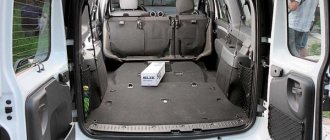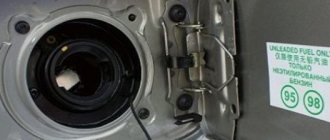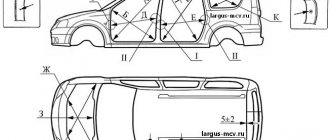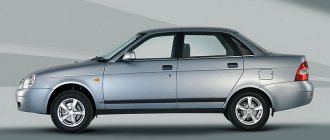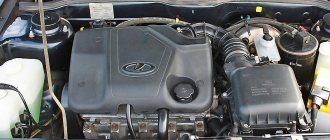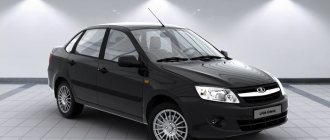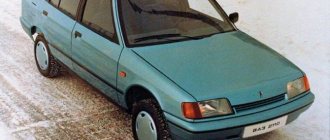On a regular Lada Largus van, the body dimensions are selected so that Euro pallets can be transported. We are talking not only about the space between the pillars, which are spaced 108 cm apart, but also about the distance between the wheel arches. It is 96 cm, and one pallet takes 80. The distance from the rear doors to the partition generally approaches two meters! A little more and it would have been possible to fit a couple of Euro pallets. Here we will look at how to remove the partition between the body and the cabin, and at the same time remove the inner bottom of the body. The first is needed for transporting long cargo, the second is also used for some reason.
We study the fastening of partitions and floors. Everything is shown in one video.
Linear dimensions of the cargo compartment of the Lada Largus van
All the sizes you need to know are shown in the photo. The van doors here are fixed at an angle of 90 degrees, but they can be opened all the way to 180. They are fixed in either of the two positions.
Luggage compartment of a Largus van
Let's list everything that is marked in the figure:
- The greatest height of the opening is 92 cm;
- Opening width – 108 cm;
- The distance “from arch to arch” is 96 cm;
- The distance from the edge of the threshold to the partition is 194 cm.
If you lay sheets diagonally, the width of the sheet should be less than 130 cm.
When the partition remains in place, the internal volume of the Lada Largus van is 2540 liters. Load capacity is 725 kg. These figures are indicated by AvtoVAZ.
In fact, the maximum lifting capacity exceeds a ton. It all depends on the road conditions and driving style.
The engine is the most important characteristic of a car
Today, two power units of different power are installed on different configurations. Both engines were developed by the Renault-Nissan alliance. Let's look at them in comparison.
| Power | Configuration | Usage |
| The first gasoline engine has 84 horsepower. The maximum indicator is achieved at 5.5 thousand rpm. | The eight-valve engine has 4 cylinders with a diameter of 7.95 cm, which are arranged in a row and total a volume of 1.6 liters. The piston stroke is 8.05 cm. | Lada Largus cross cars in standard and normal configurations are equipped with this engine. |
| The second unit has 16 valves and a power limit of 105 horsepower. They can be achieved by developing speed up to 5.75 thousand. | The structure of the cylinders and pistons is similar to the 84-horsepower engine. | The more powerful engine is only available in the luxury package. |
Interestingly, the maximum developed speed is 84 hp. With. the five-seater version is 1 km/h more than the 7-seater (156 versus 155). With a 105 hp engine, both versions can reach a maximum of 165 km/h. Acceleration to hundreds can be achieved in 14.5 seconds with an 84-horsepower unit and in 13.1 with a more powerful one.
The volume of the gas tank is 50 liters. As for consumption, in urban mode the less powerful engine consumes 0.5 liters more fuel: 10.6 liters versus 10.1. Outside the city, both engines consume the same 6.7 liters of gasoline. As a result, in the mixed cycle we have numbers of 8.2 and 7.9 liters. To maintain normal engine operation, the lubrication system must be filled with 4.8 liters of oil in a more powerful unit and 3.3 liters in an 84-horsepower unit. Largus Cross 5 seats must be fueled with A-95 gasoline.
Until recently, Renault engines came in assembled form from the concern's plant located in Spain. Later, AvtoVAZ management decided to assemble the units in Tolyatti. The operating certificate provides for a service life of at least 400,000 km. A general analysis shows that European engines are of very high quality and durable. Among the disadvantages, some points can be highlighted: spare parts for this unit are expensive; if the belt breaks, the valves bend; When refueling Largus with low-quality fuel, the engine may not control speed correctly.
Both 84-horsepower and 105-horsepower engines are paired with a five-speed manual transmission. So far, the release of the Lada Largus with an automatic transmission is not expected.
Unfasten the partition or part of it
The partition separating the body and the cabin consists of two halves. They can be removed separately. Both parts are screwed to the body with screws designed for a 13mm key size. Of course, you need a socket wrench.
Screws 1 were hidden under the casing
The four screws on the left and right are located on the cab side. And to unscrew them, remove the casing.
All actions with cladding
The left part of the septum is removed after the right. To remove only the left half, first remove both, and then mount the right sash back. Based on this, immediately decide where you will remove the trim - only on the right or on both sides.
The volume of the body on the Lada Largus van cannot be greatly increased, even if the partition is completely removed. But without the partition, by removing the seat, it will be possible to transport loads 3 meters long.
So, let's start dismantling the trim: you need to remove the seat belt (key “17”), and then unscrew one self-tapping screw. A Torx T20 wrench is suitable for the self-tapping screw.
Two parts “1” prevent the removal of casing “2”
It is necessary to unscrew all the parts numbered 1. And the casing will have to be removed, overcoming the resistance of the clamps.
Removing the partition
First, unscrew the four screws shown at the beginning of the chapter (key “13”). Then with the same key they go into the body.
All fasteners are the same
As you can see, both halves are held on three sides: top, bottom, middle. The number of screws will be as follows: four at the top and bottom, five at the seam between the sashes. Work order:
- Completely unscrew the four screws on top;
- While holding the nuts on the seam, unscrew the screws from the cabin side;
- The lower screws are unscrewed 2-3 turns. Then all parts are disengaged.
Let us remind you that the right wing can be removed separately. We wish you success.
Options and prices
Standard
Standard configuration is available in a 5-seater version for 669,900 rubles. The head optics do not have an overly complex system or content. The lights and headlights received halogen filling, and the rear lighting equipment was reinforced with additional brake lights. The basic version includes heat-insulating glazing and heated rear window, which makes the car suitable for use in the Russian climate. The roof has durable roof rails for carrying cargo. Metallic paint is only available as an option, regardless of trim level. Inside, the driver can adjust the steering column vertically. The difference between the basic version is four headrests, in the rest their number increases to five. There is only one airbag. You will also have to fork out extra money for installing the ERA-GLONASS system. Motion control systems include ABS and EBD. In-cabin amenities are limited to a cabin air filter.
Classic
A significant functional increase is available for the Classic package, which received a couple of design options. The five-seater version is sold at a price of 616,900 rubles. The Classic A/C version for 7 seats will cost the owner 646,900 rubles. The list of additional equipment included:
- power steering;
- mirrors in visors;
- central locking;
- electric drive for front windows;
- ERA-GLONASS.
Comfort
Comfort package is also available in two seating options. The minimum will cost 672,900 rubles, the extended one will cost 23,000 rubles more. Moreover, this assembly has the ability to connect gas equipment from the manufacturer. For the version with a 106-horsepower engine and a gas-gasoline power system, you will have to pay 872,900 rubles. Please note that in this case you can only count on five-person occupancy. The main changes were made to the interior, in particular, electric heating for the first row of seats, a second airbag and air conditioning appeared. Users have access to a radio, CD player with MP3 support and Hands Free. Instead of two speakers, the “Comfort” version implies the presence of four with the ability to connect AUX and USB devices. A bonus is the height adjustment of the first row seat belts.
Luxe
package opens up wide possibilities . The gasoline model will cost 706,900 rubles for 7 seats. Installing HBO automatically raises the price of the five-seater version to 893,900 rubles. The buyer can count on installation:
- front fog lights;
- heated and electric side mirrors painted in body color;
- painted door handles;
- decorative interior trim in black, gray and brown;
- driver's seat height adjustment;
- lumbar support on captain's chairs;
- full package of electric windows;
- remote control;
- rear parking sensors;
- on-board computer.
Luxe Prestige
The previous version came as close as possible to the flagship version Luxe Prestige , costing from 721,900 rubles for versions with a gasoline engine and 899,900 for the version with gas equipment on board. The differences are decorative: aluminum wheels, rear tinting, and a leather steering wheel appear. In September 2021, it became known about the release of a special version of the Lada Largus 2021 Club. The price for the modification is still unknown. The list of additions includes factory tinting and parking sensors. A badge with the hashtag #CLUB will be added to the interior and tailgate.
Options and prices (table)
| Equipment | Volume, l | Fuel | Motor, hp | Box | Dynamics up to 100 km/h, sec | Cool. moment, N×m | Drive unit | Maximum speed, km/h | Consumption in mixed cycle, l | Price, ₽ |
| Classic 5 seats | 1.6 | petrol | 87 | M.T. | 14.4 | 140 | front | 158 | 10.5 | 618 900 |
| Classic A/C 7 seats | 1.6 | petrol | 87 | M.T. | 15.4 | 140 | front | 158 | 10.5 | 648 900 |
| Luxe 7 seats | 1.6 | petrol | 106 | M.T. | 14.5 | 148 | front | 165 | 10 | 708 900 |
| CNG Comfort 5 seats | 1.6 | gas | petrol | 106 | M.T. | 13.5 | 148 | front | 165 | 10 | 874 900 |
| CNG Luxe Prestige 5 seats | 1.6 | gas | petrol | 106 | M.T. | 13.5 | 148 | front | 165 | 10 | 901 900 |
| CNG CNG Luxe 5 seats | 1.6 | gas | petrol | 106 | M.T. | 13.5 | 148 | front | 165 | 10 | 895 900 |
| Standard 5 seats | 1.6 | petrol | 87 | M.T. | 14.4 | 140 | front | 158 | 10.5 | 671 900 |
| Comfort 7 seats | 1.6 | petrol | 106 | M.T. | 14.5 | 148 | front | 165 | 10 | 687 900 |
| Luxe Prestige 7 seats | 1.6 | petrol | 106 | M.T. | 14.5 | 148 | front | 165 | 10 | 723 900 |
| Standard 5 seats | 1.6 | petrol | 106 | M.T. | 13.5 | 148 | front | 165 | 10 | 746 900 |
Prices for configurations are approximate and may vary depending on the region.
Increasing the volume of the cargo compartment (removing the excess part on the floor)
The cargo compartment volume of the Lada Largus van can be increased. To do this, remove the floor covering.
There are two types of fasteners here
We will need special Torx keys, without which the screws cannot be unscrewed: Torx T30 and T40.
Study the picture carefully:
- T40 caps (2) are located at the corners, as well as on the line between the arches;
- The remaining screws (1) are designed for Torx T30 keys.
Removing the trim will be easy. And when you install it, make rubber gaskets. They are fixed to the ends of the frame so that the casing does not rust.
The removable floor (cladding) consists of two halves - left and right. First, according to tradition, the right one is removed.
Modifications and options
The total number of modifications of the Lada Largus 2021 model year, taking into account engines, interior design and available equipment packages, reaches 15.
There are only five basic equipment levels offered by most branded car dealerships:
- Standard. Includes a driver's airbag, anti-lock brakes, brake force distribution system, 15-inch steel wheels, fabric upholstery, halogen headlights, athermal glazing, a full spare tire and an immobilizer (cost from 598 thousand rubles).
- Classic. The above equipment includes roof rails, bumpers in the color of the new body, electric front windows, heated front seats and central locking with remote control (cost from 624 thousand rubles). There is also a Classic A/C package with air conditioning and a version with a 7-seater saloon (from 677 thousand rubles)
- Comfort. A passenger airbag with a deactivation function and an audio system with MP3 support, 4 speakers, a Bluetooth system and a connector for connecting external audio devices are added (cost from 693 thousand rubles). The intermediate package CNG Comfort adds a luggage compartment curtain to the list.
- Luxe. The basic equipment of the new Lada Largus 2020 body has been expanded to include side mirrors and door handles in body color, fog lights, rear parking sensors, electric rear windows and side mirrors (+ heating), as well as an on-board computer (cost from 714 thousand rubles)
- Luxe Prestige. Factory tinted glass is added to the list of top-end equipment (cost from 729 thousand rubles)
Transmission and suspension
At the moment, the Largus Cross 5-seater car is equipped with five-speed manual transmissions of the JH3 540 and JR5 549 type. There are also 2 variations of gearboxes for the 7-seater Largus: JR5 551 and JR5 517. Each type of transmission works in tandem with a specific engine.
The French JR5 gearbox is installed on cars equipped with a more powerful 105 hp K4M engine. s., and the JH3 manual transmission is equipped with an 84-horsepower unit. These boxes are used not only on Largus, but also on other VAZ models (Vesta, X-Ray). In order to find out which gearbox the Largus Cross is equipped with, you need to look at the table located at the bottom of the crankcase.
These boxes have no fundamental differences in design. Different components are used to disengage and engage the clutch, and slightly different mechanisms are used to change gears. The units that attach the front axle drive are also slightly different. I'm pleased with the selector lever of the manual transmission. Shifts are made smoothly and the lever stroke is smooth.
French mechanics are also far superior to previous domestic developments in terms of operating sound. The Renault gearbox is quieter and does not emit as much howling and hum as was inherent in the cable mechanism of previous Lada models. But the operation of the box can still be heard. If the noise increases over time, it is more difficult to combat it in the Largus station wagon 5 seats, since the use of transmission oil is not provided. During manufacturing, transmission fluid is poured into the gearbox mechanism, which does not need to be changed during the entire service life.
Let's sum it up
We have made sure that the practical station wagon LADA Largus in the domestic market space has an undeniable leadership in terms of capacity and carrying capacity. This car also has an enviable advantage over its competitors - its price, which in most cases can tip the scales in favor of the “hero” of our article.
Curb weight: 5 seats 1260-1345 Kg 7 seats 1330-1370 Kg Van 1260-1300 Kg
Gross weight: 5 seats 1705-1790 Kg 7 seats 1810-1850 Kg Van 2010-2025 Kg
Payload 5th place 445 kg 7th place 480 kg Van 750 kg
The truck seems to be the same for everyone, the box also has a reserve, the body too, so maybe the total weight for EVERYONE
car 2025 Kg and then the payload:
5th place 680 Kg 7th place 655 Kg Van 750 Kg
Who's talking about this kind of mathematics? The question was asked not with the goal of understanding that there is an error in the PTS, but with the goal of understanding how much can actually be loaded into the car without exceeding the calculated design load.
